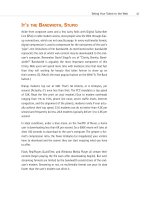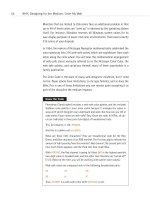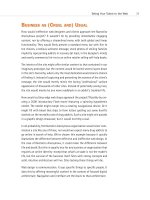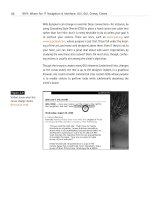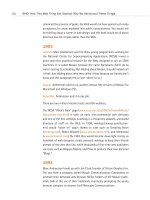Taking Your Talent to the Web- P13 pps
Bạn đang xem bản rút gọn của tài liệu. Xem và tải ngay bản đầy đủ của tài liệu tại đây (156.72 KB, 15 trang )
Figure 7.1
Is this a screenshot of an
active rollover on a web
page? Or is it a Photoshop
comp? Only its hairdresser
knows for sure.
rollover state by showing one icon that is different from the others (“rolled
over”). To make the effect crystal clear, capture an image of a mouse
cursor and lay it on top of the “active” icon in Photoshop (Figure 7.1).
161
Taking Your Talent to the Web
Present color comps and proof of concept
You have presented, articulated, and sold ideas to the client. Now you do
it again. The only difference is that the work is farther along in the process.
In addition to explaining the rationale behind design decisions and dis-
cussing the underlying technology, you also should be prepared to aurally
“sketch” what you have not yet comped up.
The client is interested not only in what you are showing; she is equally
interested in what you are not showing. “Are all the sub-pages like this
one? Will there be photographs on the message board pages, as there are
on the content pages? What happens if the search shows up empty? What
will that page look like? Does my hair look okay?”
You need to satisfy the client by describing (or “verbally storyboarding”)
these non-rendered pages. Prepare in advance. After all, you need to know
this stuff as badly as the client does. By having your answers ready, you’ll
shorten the approval process when it comes time to design the next stage.
(Client: “Oh, right, that’s the area we said would have the yellow menu bar.
Now I remember.”) You also will further instill client confidence in the
design team.
After the presentation, you will almost certainly need to make modifica-
tions. Web clients are no different than other design clients. They all have
needs they can’t quite articulate until they’ve seen some work. As in your
current job, you must know the difference between minor changes, which
may actually enhance the site, and major changes that could throw the
entire project off course. It is your responsibility to communicate the full
impact of suggested changes.
10 0732 CH07 4/24/01 11:19 AM Page 161
The presentation and revision process can go several rounds, demanding
your tact as well as your expertise. You must be able to respond positively
to client requests and return with a solution that demonstrates your
responsiveness, without jeopardizing the end product.
Receive design approval
The great day arrives! The client has signed off (well, except for one more
teeny tiny change). Now you gear up to begin translating your concept into
reality. This phase is known as development.
Development
In the development phase, web designers work with other team members
to translate site concepts into functional web pages. While you design
additional graphic elements, create Style Sheets, and possibly code web
page templates in HTML and JavaScript, producers will be marking up
dozens, hundreds, or thousands of pages, and developers will be working
to make the entire site far more functional than HTML alone allows.
Up until now, you’ve felt pretty certain about the way the site would shape
up. After all, the front page and selected sub-pages have been designed
and approved. Now, you must take the elements of all those pages and
apply them to every single page of the site. Sometimes you do all this work;
sometimes assistants or colleagues pitch in; and sometimes the work is
carried out by the equivalent of production artists, whose work you may
supervise. What is important in this phase is to maintain consistency.
Is the navigational menu on the right-hand side in all existing comps? Then
it should remain there as new pages are designed, unless there is an over-
whelmingly important reason to move it. (“It doesn’t fit on this page” is not
a legitimate rationale; it merely means you must work harder and rethink
that page. Sometimes it means you must rethink the entire site.) The con-
sistent location of navigational elements provides a vital pathfinder for vis-
itors. Imagine trying to find your way in a strange city where the street
signs kept changing color or location. No city would be that cruel or fool-
ish. Neither should any website. (Flip back to Chapter 3, “Where Am I? Nav-
igation & Interface,” for more on this subject.)
162
WHO: Riding the Project Life Cycle: We Never Forget a Phase
10 0732 CH07 4/24/01 11:19 AM Page 162
Client-branding elements also must be treated with consistency
from page to page. There are technological reasons for this, as well as psy-
chological ones.
Psychologically, if the logo is always 32 x 32 pixels and always at the top
left, visitors expect to see it there on all pages. Such consistency reassures
visitors that they are still in the same “place” on the Web. After all, the Web
is a fluid and limitless medium, and the client’s site is just a drop in that
vast ocean. Consistent branding orients web users; inconsistent branding
disorients them. Love your audience and provide the markers they need to
know where they are (and your clients will think you’re doing it for them).
Technologically, once a graphic element is cached in the visitor’s browser,
it need not be downloaded again. Because most visitors use slow dialup
modems, the less downloading, the faster the site and the better the user
experience. Thus, if the same 32 x 32 image appears on every page, there
is no need for additional downloads, and each page of the site will appear
that much faster. (Refer to the discussion in Chapter 2, “Designing for the
Medium,” regarding bandwidth and caching if you’ve forgotten how this
works or why it matters.)
During the development phase, you’ll do things such as:
■ Create all color comps
■ Communicate functionality
■ Work with templates
We provide tips and pointers in the following sections.
Create all color comps
As you have seen, the design phase demanded the creation of selected color
comps. During development, one or more web designers will create color
comps for all pages. Depending on client expectations, the design team also
may show these comps to the client for approval.
163
Taking Your Talent to the Web
10 0732 CH07 4/24/01 11:19 AM Page 163
As the team creates each color comp, technicians or junior designers will
cut it apart in Adobe ImageReady or Photoshop 6, Macromedia Fireworks,
or another similar software program. This process converts the color comp
into component elements, and these are finally assembled into a working
web page built with HTML and other web languages or with a What You
See Is What You Get (WYSIWYG) web layout program, such as
Dreamweaver. This is not the only way to create web pages, nor (in our
opinion) is it necessarily the best way. It is the primary technique used in
most shops, however, and every web designer should master the process.
Communicate functionality
Refer to the previous discussion on rollovers or image swapping, as it
can be called. In some web firms, the web designer will code those image
swaps in JavaScript. In other firms, the web designer merely articulates a
desired effect (complete with Photoshop comps), and a developer or web
technician writes the necessary code.
Functionality can include CGI and Java (for forms, e-commerce, message
boards, and chat functions), JavaScript (for special interactive visual
effects as well as less glamorous browser detection, plug-in detection,
forms validation, and so on), plug-in technologies (Flash, QuickTime, or
RealVideo), and beyond.
The communication travels both ways. At times the technologist will
explain intentions or limitations to the web designer; at other times the
web designer calls the shots. Web designers are not expected to know Java
programming or MySQL. Many web designers do not even work in Flash.
What’s expected is that you know enough about these formats and lan-
guages to work with those who specialize in them, articulating your vision
or responding to the direction of others.
By the way, we despise the word “functionality” even more than we hate
phrases such as B2B or B2C. Alas, it seems to be the best word for the job.
Former English majors, check your emotions at the door. This business has
more buzzwords than a venture capitalist convention.
164
WHO: Riding the Project Life Cycle: We Never Forget a Phase
10 0732 CH07 4/24/01 11:19 AM Page 164
Work with templates
In some cases, sites change very little over time. More commonly, the site
you design functions as a placeholder or shell for ever-changing content.
Sometimes this changing content is managed by the web agency. If the
client updates infrequently, you can simply write new HTML and create new
images to accommodate occasional changes like these. More often, your
clients will update their own sites, with mixed results. (We’ll be whining
about that later in the book.)
Today, content is often changed dynamically, by means of various backend
technologies. In such cases, you are not so much designing pages as you
are templates—visual and markup placeholders in which content will be
updated by means of a publishing system or in response to dynamic data-
base technology. The work is essentially the same as “traditional”
web design but involves special considerations that will be articulated by
the technologists on the team. (See Chapter 12 for more.)
Design for easy maintenance
In the best of all possible worlds, the web design team retains control over
the site as it evolves over the months and years. Control is usually accom-
panied by a retainer fee, which is negotiated at the very beginning of the
process. In reality, more and more clients assume control over the site when
it is delivered.
Designers and coders should always create highly structured and well-
documented work, so that they can easily go back to it and update it with-
out hunting for missing files, debugging errant file references, and so on
(or so that their clients, upon assuming control of the site, can perform
these tasks without damaging the site).
Upon finishing the site, you’ll accompany it with a style guide and docu-
mentation. These will be much easier to create if the site’s file structure
and naming conventions make sense to begin with.
165
Taking Your Talent to the Web
10 0732 CH07 4/24/01 11:19 AM Page 165
For you, this means titling the logo image “logo.gif” instead of “uglyswirl-
withstupidbevel.gif,” calling the November header graphic “nov_head.gif,”
and so on. For the web technician (or you, if you write your own HTML),
this means naming the disclaimer page “disclaimer.html,” storing images
in a single directory labeled “Images,” and so on.
If care is taken throughout the development process, then updating and
maintaining the site will be easy and logical, whether updates are per-
formed by you, a production person, or your client.
Testing
Though a web development team will test its product throughout the proj-
ect life cycle, many web projects plan for a distinct testing phase. In this
phase, the development team has the opportunity to test the deliverable
against the design and functionality specifications.
In some cases, real users may test a site. In other cases, a specially trained
testing team will do the job. Testing by real users usually tells you more
about the site. We often get the most useful feedback by showing work to
the guys who deliver sandwiches. Be elitist in choosing typefaces but dem-
ocratic in designing interfaces. The Web is for people, not for experts.
Regardless of the testing technique involved, team members must work
together to track down the source of problems and implement solutions.
We guarantee that there will be problems. For one thing, no two web
browsers interpret code and markup exactly the same way (see Chapter 2).
For another, what seems clear to you may be baffling to the people who
use your site. Web designers tend to live two years ahead of the curve; web
users, who actually have lives, tend to live behind the curve. You know that
little rotating box takes visitors back to the home page; visitors may not.
Testing will reveal problems in browser compatibility and user acceptance;
then it’s up to you and your team to solve those problems.
Deployment
You’ve completed the site. The client has signed off on it. The files have
been transferred to the web server. Think you’re finished? Not quite yet.
Successful projects demand a smooth transition from the web team to the
client.
166
WHO: Riding the Project Life Cycle: We Never Forget a Phase
10 0732 CH07 4/24/01 11:19 AM Page 166
The updating game
In the early days, clients viewed the web designer as a species of magician.
They knew they had to have a web presence, whatever that meant, and they
felt that you held their fate in your hands. Not only were they eager to
approve what you created (because it was all magic to them), they also
were more than willing to retain you as the perpetual updater and refresher
of their online identity.
Then came FrontPage, GoLive, and Dreamweaver—tools that theoretically
let “anybody make a website,” whether they knew what they were doing
or not. Now, the possession of FrontPage does not turn your client into
a web designer any more than ownership of a Roland Drum
Machine turns the neighbor’s kid into Keith Moon. But the ability to gen-
erate HTML, the language with which web pages are created, has con-
vinced too many clients that they can save a buck or two by
purchasing one of these web-editing tools and updating their sites them-
selves. The results are often disastrous, for reasons that will be obvious to
any creative professional, but incomprehensible to many clients, whose
esthetic sensibilities have been shaped by cooking up pie charts in Power-
Point. Not that we’re bitter.
There are several ways to manage the transition. In one of the better
scenarios, you’ve designed a database-generated site for a large client with
much money and created a custom publishing tool enabling them to add
fresh content to the mix without befouling the site.
Alternatively, instead of providing clients with a custom publishing tool,
you might hook them up with an existing product, such as Zope
(www.zope.org) or Allaire Spectra (www.allaire.com). Some of these tools
use standard web languages such as HTML and XML; many use custom
markup and are part of larger proprietary product families. Some are sim-
ple enough for a client to use; others require considerable developer
involvement, which is one way of keeping your finger in the pie—if that’s
your idea of fun. What you gain in billings you may lose in IT people, who
quit from the frustration of continually guiding clients through complex
processes requiring specialized knowledge. This, however, is your boss’s
worry, not yours (unless you own the web agency).
167
Taking Your Talent to the Web
10 0732 CH07 4/24/01 11:19 AM Page 167
In still other cases, your client will assign an in-house person or team to
take over the site. Sometimes these folks are in-house designers with solid
web experience. Sometimes they’re overworked marketers with a copy of
FrontPage.
Regardless of how the site is updated and by whom, in this final phase of
development, you get one more opportunity to preserve your work and
serve your client by creating documentation, providing client training, and
maintaining contact on a consulting basis.
Create and provide documentation and style guides
“Care and Feeding” instructions accompany everything from puppies
to houseplants, and websites demand the same loving attention. It is
important to provide the client with detailed notes on the location of files,
the fonts and color palettes used, photographers or illustrators involved,
and so on.
As more and more clients plunge into the business of updating their own
sites, it is vital to provide them with every possible scrap of information. If
you don’t take pains with this postpartum part of the process, your client
may paint a moustache on your Mona Lisa or send visitors running for their
lives when a Style Sheet or JavaScript file is accidentally deleted.
Remember: A book design is a book design, a finished ad is a finished ad,
but a website is never finished, and the client can always louse it up. Do
everything in your power to save your clients from themselves.
By the way, such documentation should be created even if the web agency
retains control of the project (including updating and maintenance). After
all, six months from now, do you really want to scratch your head trying to
remember which font you used, where your navigational menu graphics
were stored, or which script was responsible for a given function? Of course
not. This documentation will be easier to create, and the site will be easier
to update if you’ve followed the advice given earlier in this chapter and
designed for easy maintenance by establishing and following logical nam-
ing and structural conventions.
168
WHO: Riding the Project Life Cycle: We Never Forget a Phase
10 0732 CH07 4/24/01 11:19 AM Page 168
Provide client training
Sometimes it is enough to tell your clients which fonts and colors you used.
Sometimes it is enough to tell your children not to play with matches.
Usually, it is not enough. That’s why, whenever possible, the designer and
other team members should have after-meetings to discuss the site in
detail and provide as much client training as possible.
Besides helping the client avoid ruining a beautiful site, in-house training
also sends the message that your company cares. Clients who know you
care will come back with additional projects and will tell their friends on
the golf course about the integrity of your company.
If your clients are going to be writing HTML or (bless us) creating new
images, it is worth sitting down with them, at their computer or yours, and
pointing out the fine nuances of what you’ve done. You might even buy
fonts for them (matching the fonts you used), install the fonts on the
client’s computer, and show them how to work with Extensis Suitcase or
Adobe Type Manager Deluxe.
You may feel ludicrous doing this, especially if the client is not a graphic
designer, but it’s foolish to underestimate other people’s creative potential.
Besides, if they’re going to do the work anyway, you owe them and your-
self every possible assistance.
This whole thing is fairly unsavory, we’re afraid. It’s rather like a dentist
training patients to extract their own teeth, but it is an aspect of the busi-
ness, and coping is better than lamenting.
Learn about your client’s methods
Training is often bi-directional. While explaining your methods to an in-
house peer (or turning a client into a junior web designer of sorts), you also
should learn as much as you can about the way your client will work with
the site. If possible, you should learn about the software your client will be
using. It’s highly unlikely that your client will create HTML and other web
markup by hand. Fortunately, the number of WYSIWYG web editors con-
sidered good enough to use is fairly limited, so you can learn the basics and
pitfalls of your client’s software of choice even if you never touch the stuff
yourself.
169
Taking Your Talent to the Web
10 0732 CH07 4/24/01 11:19 AM Page 169
We recently ran into a puzzling problem where the web typography we had
established via Style Sheets kept disappearing from the client’s site after
he took it over. We had written a Global Style Sheet, placed it in a secure
location, and instructed the client never to touch it. Yet every time he
updated the front page, the Style Sheet reverted to an early, inferior vision,
and the client was constantly contacting us to ask why the site was going
to Hell.
Eventually we discovered that a site maintenance feature built into the
client’s software was the culprit behind the Case of the Changing Style
Sheet. When the client updated his index page, his software program asked
if he wanted to “upload related files.” Because that sounded like a pretty
good idea, the client always clicked Yes. The program then automatically
uploaded dozens of files from his hard drive to the server. An old Style Sheet
on his hard drive was automatically replacing the newer one we had cre-
ated. We re-sent him the updated Style Sheet, instructed him to turn off
the site maintenance feature, and from then on, all was well.
WORK THE PROCESS
The process you’ve just read about varies by agency, but the general out-
lines and the lessons involved should hold true for most companies and
projects. Some agencies keep themselves fairly aloof from their clients and
manage to do wonderful work in spite (or because) of it. Others become
deeply involved with their clients, establishing long-lasting, trust-based
relationships.
Some hold their clients to ironclad contracts and schedules, while others
are loose and almost playful in their approach. Some shops show the client
exactly one comp—take it or leave it. Others cover the walls. Some agen-
cies charge astronomical fees merely to write a proposal; others write pro-
posals, design comps, and create storyboards on spec—a terribly ill-advised
approach, but not as rare as it ought to be.
170
WHO: Riding the Project Life Cycle: Work the Process
10 0732 CH07 4/24/01 11:19 AM Page 170
The main thing to remember is that every phase, every step of the process,
is potentially empowering. If you use initial meetings to establish trust and
help sharpen the client’s vision, you will find yourself working on sites
worth designing—for clients who respect you instead of mistrusting and
fighting with you. If you use the design phase to fully explore possibilities,
you will come up with richer designs and avoid structural problems in the
implementation phase. If you cooperate with team members and your
client during the production phase, you will encounter fewer problems dur-
ing testing. If you train your clients respectfully, your best efforts will be
preserved, you’ll be able to look at your old sites without experiencing nau-
sea, and the credibility of your work will win you new and better projects.
171
Taking Your Talent to the Web
10 0732 CH07 4/24/01 11:19 AM Page 171
10 0732 CH07 4/24/01 11:19 AM Page 172
Part III
HOW: Talent Applied
(Tools & Techniques)
8 HTML, the Building Blocks of Life Itself 175
9 Visual Tools 209
10 Style Sheets for Designers 253
11 The Joy of JavaScript 285
12 Beyond Text/Pictures 327
13 Never Can Say Goodbye 387
11 0732 Part III 4/24/01 11:20 AM Page 173
11 0732 Part III 4/24/01 11:20 AM Page 174
chapter 8
HTML, the Building
Blocks of Life Itself
ASWE’VE SAID THROUGHOUT THIS BOOK, HTML is a simple language for creating
documents that adhere to structured outlines.
<h1>Headline</h1>
<h2>Subhead</h2>
<p>Paragraph.</p>
<p>Second paragraph.</p>
<p>Third paragraph.</p>
<h3>Subordinate subhead</h3>
<p>Paragraph.</p>
<p>Second paragraph.</p>
<p>Third paragraph.</p>
<address>Contact information, copyright, date of publication</address>
Rocket science it’s not, nor was it intended to be. All great ideas should be
this simple. Notice that the tags (that’s what the lines are called—tags)
suggest their functions: <p> for paragraph, <h1> for first-level headline,
<address> for contact information. Notice also the fine symmetry in this
simple example. You open a <p> and you close it </p> when you’re done.
You open a <h3> subhead and </h3> close it before moving on to another
tag. In this way, the browser knows that one tag has closed before another
begins. In HTML, the closing of some tags is mandatory, while with other
12 0732 CH08 4/24/01 1:22 PM Page 175




